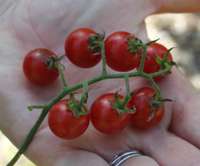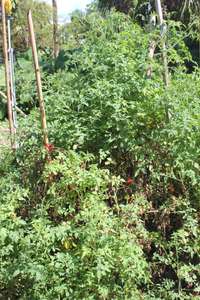
Figure 8. Fruit of wild tomato. Source: Tim Motis
The wild tomato (Solanum pimpinellifolium) is a different species than the standard tomato (Solanum lycopersicum), though the two species are cross-compatible, meaning they can cross-pollinate and produce viable offspring. Wild tomatoes produce many hands/bunches of tiny fruit (Figure 8) on very large, sprawling plants that live up to their name.
The bite-sized fruit has soft skin and is easily added to salads, requiring no processing. The fruits are known for their rich flavor. Wild tomato fruits are easy to harvest, with minimal damage to the skin. Wild tomato is a good option for hot, humid conditions. Most cultivated tomatoes are susceptible to diseases, especially in hot, humid weather. Spraying and using disease-resistant varieties is often necessary to produce a good tomato crop with standard varieties. The wild tomato, however, is naturally disease and heat resistant, so it performs well even when standard tomatoes would struggle.
Wild tomato is an excellent addition near a house or on the border of a field, as it is perfect for harvesting and eating out of hand when you are hungry. It is an open-pollinated heirloom, and you can save the seed from year to year.
Tradeoffs
One of the tradeoffs of wild tomato is that the plants are large and take up a lot of space. One plant can grow to a diameter of 3.6 m if left unmanaged. They are not suitable for a small garden with limited space, so we recommend planting them along a fence line, in an area where they can sprawl, or on a raised bed with a trellis.
The next tradeoff can also be a benefit. Because wild tomato and standard tomato are cross-compatible, genes of wild tomato can mix with those of other tomato varieties flowering at the same time and grown too close together.5 This crossing would only be an issue if you are saving the seeds and want the tomato varieties in your garden to remain pure. On the positive side, you can cross local tomatoes with wild tomato to introduce disease resistance. A project like that takes time and requires careful observation. Genes related to fruit quality and plant growth will mix, so you would need to record specific characteristics observed in subsequent generations and save seeds from plants with desirable traits.
Another tradeoff is that the fruit does not last long off the vine and does not travel well. It is best to consume fruit during the first day or two after harvest.
Lastly, the plants often reseed themselves, from fruits that drop to the ground or are spread by birds. Remove unwanted volunteer seedlings.
Cultivation
I seed and plant the wild tomato at the same time as standard tomatoes for my area. However, you can plant them a few weeks earlier and a few weeks later than usual in subtropical and tropical climates to extend the growing season. If planting in a temperate climate, I would plant them during the typical tomato growing season, and they should continue to bear fruit for an extra month or two after the regular growing season. It takes about 90 days to obtain the first harvest of fruit after planting seeds.
Sow seeds into nursery beds, small containers, or trays for starting seedlings. When the resulting seedlings have three to five leaves, transplant them into the garden 1 m apart within rows and 2 m between rows. This spacing might seem excessive, but it is not; they need a lot of space.

Figure 9. Growth habit and size of wild tomato. Source: Tim Motis
Wild tomato plants need water, especially as they are getting established, and fertile soil amended with phosphorus will increase productivity. We have also had volunteer wild tomato plants appear along fence lines that did great without any watering or fertilizing on our part. So, the plants do better when watered and fertilized, but they can also grow without much attention and input.
If you want to make the fruit more accessible and minimize disease problems, support the plants with a trellis (Figure 9). Keeping the canopy above the ground helps keep the leaves dry, preventing diseases that spread rapidly under wet conditions. Wild tomato has many side branches but trellising in a weave pattern6 helps keep the main plant supported so that fruit is visible. The plants will engulf tomato cages, making them unsuitable as supports. You can also let plants go unmanaged, but they will need more space to crawl and sprawl since they will not be encouraged to grow upwards.
Seeds
Active development workers who are members of ECHOcommunity.org may request a trial packet of seed. (See the website for how to register as a member and how to order seeds.)
Reference
McCormack, J.H. 2004. Tomato seed production: an organic seed production manual for seed growers in the Mid-Atlantic and Southern U.S. www.savingourseeds.org. Version 2.6 [NOTE: The manual summarizes factors affecting the distance over which cross-pollination of tomatoes can occur. A companion manual entitled ‘Isolation Distances’, also found at www.savingourseeds.org, provides more in-depth information on keeping seed varieties pure.]
Cite this article as:
Sobetski, H. 2021. Everglades (Wild) Tomato. ECHO Development Notes no. 151.